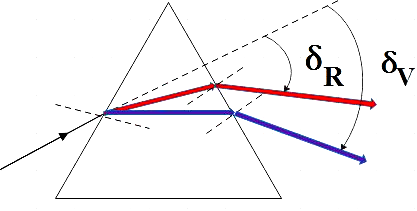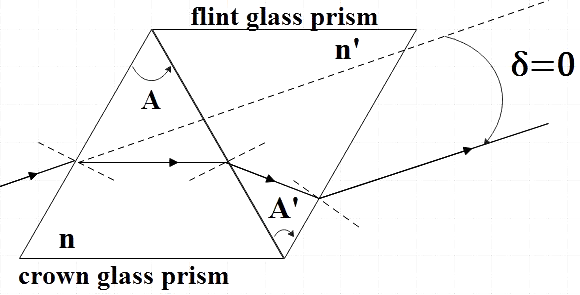
Answer
446.1k+ views
Hint: As per the given question, we can understand that the sum of deviation caused by the prism combination is zero, in other words, deviation caused by one is the negative of that caused by another. We could now express the deviations of the prisms in terms of their respective prism angles and then equate the relation for one of the prisms as the negative of the other. Rearranging the terms will now lead you to the required ratio.
Formula used: $\delta =\left( \mu -1 \right)A$
Complete step by step answer:
We know very well that, when a white light is incident on a glass prism, it gets dispersed into its constituent colors. This happens because light with different wavelengths are getting bend in varying amounts.

${{\delta }_{v}}$, ${{\delta }_{R}}$ are the deviations that has occurred for red light and violet light from the path that it would have followed in the absence of the prism.
So we are given two glass prisms - flint glass prism and crown glass prism, and they are arranged in such a way that resultant deviation caused by them is zero.

The ray represented in this diagram is the mean ray. The light incident on the surface of flint glass prism is bent due to change in refractive index. Let the deviation caused due to the presence of flint glass prism be${{\delta }_{f}}$. The light is further bent when it hits the flint–crown interface and let the deviation caused due to crown glass prism alone be $\delta c$.
We are provided in the question that this arrangement results in dispersion without deviation. Therefore, the sum of deviations of both glass prisms should be zero. That is,
${{\delta }_{total}}={{\delta }_{f}}+{{\delta }_{c}}=0$
Clearly,
${{\delta }_{f}}=-{{\delta }_{c}}$ …………………….. (1)
The relation between the angle of prism and the deviation caused by it is given by,
$\delta =\left( \mu -1 \right)A$ …………………. (2)
Where, μ is the refractive index of the prism.
We are given n and n’ as the refractive indices of flint glass and crown glass, also, A and A’ as their respective angles of prism.
Equation (2) for flint glass and crown glass are,
${{\delta }_{f}}=\left( n-1 \right)A$ ………………. (3)
${{\delta }_{c}}=\left( n'-1 \right)A'$ ……………… (4)
Substituting (3) and (4) in (1) gives,
$\left( n-1 \right)A=-\left( n'-1 \right)A'$
Therefore,
$\dfrac{A}{A'}=-\left( \dfrac{n'-1}{n-1} \right)$
So, the correct answer is “Option B”.
Note: Here, the deviation caused by one prism is negative of the other, thereby resulting in zero deviation. Though deviation is absent, we could still observe dispersed light at the end of this arrangement. Absence of deviation just means that, at the end, the light traces the path that is parallel to the one it would have taken in the absence of this arrangement.
Formula used: $\delta =\left( \mu -1 \right)A$
Complete step by step answer:
We know very well that, when a white light is incident on a glass prism, it gets dispersed into its constituent colors. This happens because light with different wavelengths are getting bend in varying amounts.

${{\delta }_{v}}$, ${{\delta }_{R}}$ are the deviations that has occurred for red light and violet light from the path that it would have followed in the absence of the prism.
So we are given two glass prisms - flint glass prism and crown glass prism, and they are arranged in such a way that resultant deviation caused by them is zero.

The ray represented in this diagram is the mean ray. The light incident on the surface of flint glass prism is bent due to change in refractive index. Let the deviation caused due to the presence of flint glass prism be${{\delta }_{f}}$. The light is further bent when it hits the flint–crown interface and let the deviation caused due to crown glass prism alone be $\delta c$.
We are provided in the question that this arrangement results in dispersion without deviation. Therefore, the sum of deviations of both glass prisms should be zero. That is,
${{\delta }_{total}}={{\delta }_{f}}+{{\delta }_{c}}=0$
Clearly,
${{\delta }_{f}}=-{{\delta }_{c}}$ …………………….. (1)
The relation between the angle of prism and the deviation caused by it is given by,
$\delta =\left( \mu -1 \right)A$ …………………. (2)
Where, μ is the refractive index of the prism.
We are given n and n’ as the refractive indices of flint glass and crown glass, also, A and A’ as their respective angles of prism.
Equation (2) for flint glass and crown glass are,
${{\delta }_{f}}=\left( n-1 \right)A$ ………………. (3)
${{\delta }_{c}}=\left( n'-1 \right)A'$ ……………… (4)
Substituting (3) and (4) in (1) gives,
$\left( n-1 \right)A=-\left( n'-1 \right)A'$
Therefore,
$\dfrac{A}{A'}=-\left( \dfrac{n'-1}{n-1} \right)$
So, the correct answer is “Option B”.
Note: Here, the deviation caused by one prism is negative of the other, thereby resulting in zero deviation. Though deviation is absent, we could still observe dispersed light at the end of this arrangement. Absence of deviation just means that, at the end, the light traces the path that is parallel to the one it would have taken in the absence of this arrangement.
Recently Updated Pages
Who among the following was the religious guru of class 7 social science CBSE

what is the correct chronological order of the following class 10 social science CBSE

Which of the following was not the actual cause for class 10 social science CBSE

Which of the following statements is not correct A class 10 social science CBSE

Which of the following leaders was not present in the class 10 social science CBSE

Garampani Sanctuary is located at A Diphu Assam B Gangtok class 10 social science CBSE

Trending doubts
Derive an expression for drift velocity of free electrons class 12 physics CBSE

Which are the Top 10 Largest Countries of the World?

Write down 5 differences between Ntype and Ptype s class 11 physics CBSE

The energy of a charged conductor is given by the expression class 12 physics CBSE

Fill the blanks with the suitable prepositions 1 The class 9 english CBSE

Derive an expression for electric field intensity due class 12 physics CBSE

How do you graph the function fx 4x class 9 maths CBSE

The Equation xxx + 2 is Satisfied when x is Equal to Class 10 Maths

Derive an expression for electric potential at point class 12 physics CBSE



